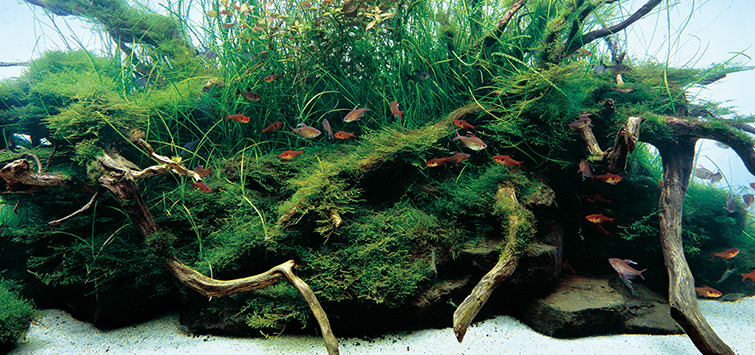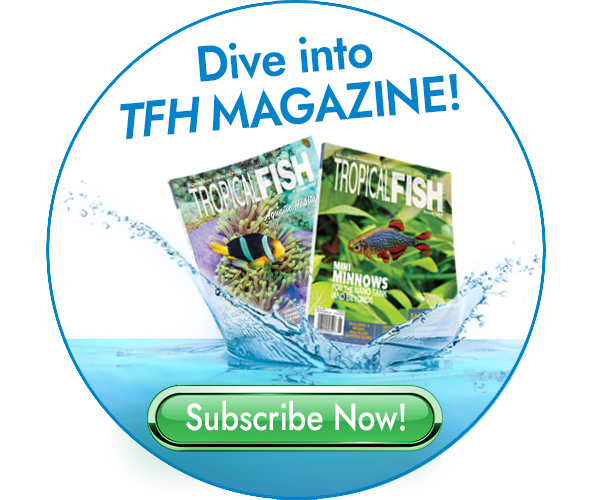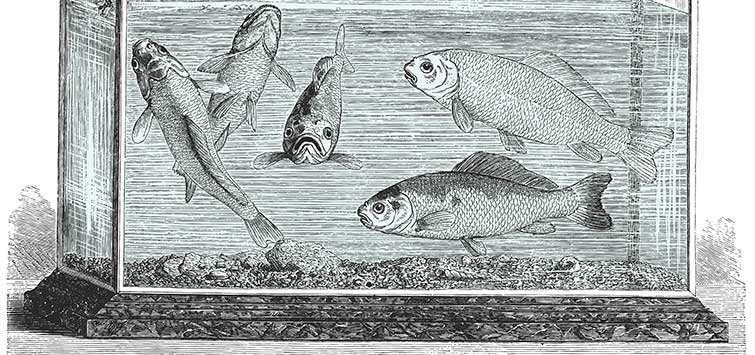Enjoying a Layout Longer by Replanting the Background
Author: Takashi Amano
As time passes, stem plants in the background of a Nature Aquarium layout can decline and require replanting. The master aquascaper explains how to work with these plants to maximize a layout’s longevity.
Replacing Plants
In the previous article, I discussed a way to enjoy a Nature Aquarium layout over a long period of time by replacing all the aquatic plants in the layout while keeping the framework of the composition intact. I am going to introduce another method in this article that allows you to accomplish the same thing by replacing only the plants that have become difficult to maintain in the layout.
Characteristics of Stem Plants
Various combinations of aquatic plants are used in aquatic plant layouts, including Nature Aquarium layouts. Aquatic plants grow differently and at different speeds depending on their types. The type of aquatic plants that grow vertically at a fast speed, such as stem plants, need to be maintained through repeated trimming. Stem plants generally develop multiple new side shoots when their terminal buds are cut off. Their stems and leaves will become denser as this process is repeated. While the newly developed stems at the top are young and fresh, the original stems at the substrate grow older and decline gradually.
Although this depends on the type of stem plant, older plants need to be rejuvenated after a while by cutting off the older part of the stems and replanting the top part. The younger top part is replanted since aged stems do not develop new shoots well. This type of replanting is essential for the long-term maintenance of a layout with stem plants in the background.
Undergrowth Plants
In contrast to stem plants, undergrowth plants in the foreground, such as Glossostigma and Echinodorus tenellus, spread sideways by developing runners. Therefore, they can be maintained over a long period of time by trimming the top layer of the plants or by cutting off runners and thinning the plants when the runners and leaves form a mat. Additionally, sciophytic (shade-loving) plants in the midground, such as ferns and Anubias, do not require trimming like heliophytic (light-loving) plants, such as stem plants, do since they grow relatively slowly. Thus, in order to enjoy a typical aquatic plant layout over a long period of time, periodically rejuvenating existing stem plants by replanting their top part or replacing all the stem plants in the background will become a primary task. Compared to the background, the foreground and the midground are much easier to maintain.
Maintaining Stem Plants
In order to rejuvenate the existing stem plants in the background, the stem plants need to be pulled out of the substrate temporarily. Since stem plants also take root in the substrate, detritus in the substrate will be stirred up and cloud the water as the stem plants are pulled up in the water. If such dirty water enters a fish’s gills, it can cause the fish to get sick. Therefore, fish should be moved temporarily to another tank or container with the clean tank water before pulling up stem plants. Additionally, draining as much water from the tank as possible beforehand makes it easy to pull up the stem plants.
Once the stem plants have been removed, the substrate will be disturbed, with a part of the nutritive soil substrate dug up and some of the nutritionally enhanced sand exposed. New soil should be added on top of the substrate, and the surface should be smoothed out. If you are going to replant the existing stem plants, they should be cut to a uniform length and the upper young stems should be planted.
Changing a Layout
The same general procedure also applies when replacing the plants with new stem plants. The appearance of the layout will not change when the existing plants are replanted. On the other hand, if the layout is replanted with new and different aquatic plants, the appearance of the layout will change dramatically and you can enjoy the same layout with a fresh, new impression. It is important to revamp the impression of a layout when maintaining a layout for a long period of time. I call this type of replanting Sozo Haishoku (creative plant rearrangement).
The layout in this article was replanted using this method. A collection of various stem plants that are planted in a semispherical media made of plant materials was used in this remake instead of planting aquatic plants with tweezers. Since the aquatic plants have been grown and already taken root in the media, planting is finished by simply placing the sphere on top of the substrate. These stem plants are grown much more densely than those planted one at a time into the substrate with tweezers. Because they have sturdy emersed-grown leaves, they develop healthy submersed-grown leaves rapidly under water.
A variety of stem plants are used to produce the sphere. The majority of the stem plants that are used in this layout are large pearl grass, Rotala indica, and Polygonum sp. They also include a small number of needle leaf Ludwigia and Ambulia. As in the case of stem plants planted in the substrate, the plants on the sphere are also maintained through repeated trimming. Since these stem plants are quite tolerant of trimming, they do not have to be replanted as often. Replanting the top part of the sphere requires much less work, since you can simply cut off the roots and remove the stem plants by the base.
Data
Aquarium: Cube Garden W90 x D45 x H60 cm
Lighting: Solar I (NAG-150W-Green) x 3 units over two 90 cm H tanks, turned on for 10 hours per day
Filter: Super Jet Filter ES-1200 (Bio Rio M, NA Carbon)
Substrate: Aqua Soil Amazonia, Power Sand Special L, Bacter 100, Clear Super, Penac W/for Aquarium, Penac P, Tourmaline BC
CO2: Pollen Glass Large 30, 3 bubbles per second via CO2 Beetle Counter (using Tower)
Aeration: For 14 hours after the light is turned off using Lily Pipe P-4
Additives: Brighty K, Green Brighty STEP2
Water Change: 1/3 once a week
Water Quality: Temperature 25ºC (77ºF), pH 7.0, TH 20 mg/l
Aquatic Plants: Micranthemum umbrosum, Rotala rotundifolia, Polygonumsp., Ludwigia arcuata, Limnophila sessiliflora, Glossostigma elatinoides, Echinodorus tenellus, Microsorum sp. “narrow leaf,” Fontinalis antipyretica
Fish/Invertebrates: Hemigrammus rodwayi, Hyphessobrycon rosaceus, Hyphessobryconsp., Otocinclus sp., Crossocheilus oblongus, Caridina japonica
See the full article on TFH Digital http://www.tfhdigital.com/tfh/201204#pg57

.png?h=595&iar=0&w=2781&hash=5FD5E69473BCC22199FBFA2FB71B6033)



